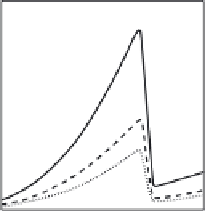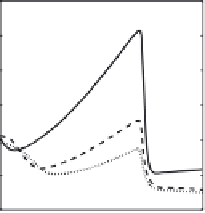Geoscience Reference
In-Depth Information
400
6
b
a
5
300
4
1
1
200
3
2
2
2
100
1
3
3
0
0
2
3
4
5
6
2
3
4
5
6
L
−
shell
L
−
shell
Fig. 6.6.
(a) The FLR-period and (b) relative decrement versus
L
. Exponent
p
=6
in (6.76) describing the field-aligned plasma distribution. Indexes refer to the 1-st,
2-nd and 3-rd harmonics
L
pp
. These results for
δ
i
do not contradict the ones
obtained from the experimental data.
The resonance periods
T
res
(left frame) and decrements
γ
(right frame)
as functions of the
L
-shell for the first three harmonics are shown in Fig. 6.6
for the cold plasma distribution (6.76) with
p
= 6. Figure 6.7 represents the
half-widths
δ
L
(
L
) of three harmonics for the distributions with exponent
p
= 6 (left frame) and
p
= 3 (right frame). At
p
= 3 the harmonics are not
equidistant and it is possible to use this fact in sounding the magnetosphere
by estimating the parameter
p
. The decrement and the resonance half-width
in the regions 2
∼
10 km at
L
about
4
.
5 for the 3-rd
harmonic are almost constant and the resulting shape of the resonance curve
changes weakly in these ranges of
L
.
Note also that
γ
decreases in the thin ionosphere with harmonic number.
Contrary, the finite ionospheric thickness leads to the growth of the relative
L
4
.
5 for the 2-nd harmonic and 3
L
× 10
2
× 10
2
2
2
1,2,3
1,2,3
0
0
3
3
2
2
−
2
−
2
2
1
1
1
−4
1
−4
2
−6
−6
2
3
4
5
6
2
3
4
5
6
L
-
shell
L
-
shell
Fig. 6.7.
The half-widths
δ
L
in the magnetosphere for the first three resonance
harmonics functioning
L
. The curves are calculated for the field-aligned plasma
distributions with exponent
p
= 6 (left panel) and
p
= 3 (right panel) of (6.76)



































Search WWH ::

Custom Search